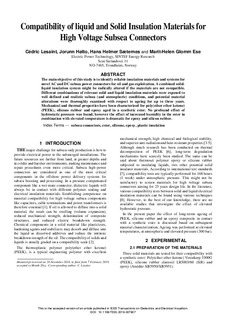| dc.contributor.author | Lesaint, Cedric Michel | |
| dc.contributor.author | Hølto, Jorunn | |
| dc.contributor.author | Sæternes, Hans Helmer | |
| dc.contributor.author | Ese, Marit-Helen Glomm | |
| dc.date.accessioned | 2019-08-19T06:38:13Z | |
| dc.date.available | 2019-08-19T06:38:13Z | |
| dc.date.created | 2019-08-15T07:33:07Z | |
| dc.date.issued | 2019 | |
| dc.identifier.citation | IEEE transactions on dielectrics and electrical insulation. 2019, 26 (4), 1139-1145. | nb_NO |
| dc.identifier.issn | 1070-9878 | |
| dc.identifier.uri | http://hdl.handle.net/11250/2608885 | |
| dc.description.abstract | The main objective of this study is to identify reliable insulation materials and systems for novel AC and DC subsea power connectors for oil and gas exploitation. A combined solid-liquid insulation system might be radically altered if the materials are not compatible. Different combinations of relevant solid and liquid insulation materials were exposed to well defined and realistic subsea (and atmospheric) conditions, and potential material alterations were thoroughly examined with respect to ageing for up to three years. Mechanical and thermal properties have been characterized for poly(ether ether ketone) (PEEK), silicone rubber and epoxy aged in a synthetic ester. No profound effect of hydrostatic pressure was found, however the effect of increased humidity in the ester in combination with elevated temperature is dramatic for epoxy and silicon rubber. | nb_NO |
| dc.description.abstract | Compatibility of liquid and solid insulation materials for high voltage subsea connectors | nb_NO |
| dc.language.iso | eng | nb_NO |
| dc.publisher | IEEE | nb_NO |
| dc.rights | Navngivelse 4.0 Internasjonal | * |
| dc.rights.uri | http://creativecommons.org/licenses/by/4.0/deed.no | * |
| dc.title | Compatibility of liquid and solid insulation materials for high voltage subsea connectors | nb_NO |
| dc.type | Journal article | nb_NO |
| dc.type | Peer reviewed | nb_NO |
| dc.description.version | acceptedVersion | nb_NO |
| dc.source.pagenumber | 1139-1145 | nb_NO |
| dc.source.volume | 26 | nb_NO |
| dc.source.journal | IEEE transactions on dielectrics and electrical insulation | nb_NO |
| dc.source.issue | 4 | nb_NO |
| dc.identifier.doi | 10.1109/TDEI.2019.007907 | |
| dc.identifier.cristin | 1716051 | |
| dc.relation.project | Norges forskningsråd: 228344 | nb_NO |
| cristin.unitcode | 7548,30,0,0 | |
| cristin.unitname | Elkraftteknologi | |
| cristin.ispublished | true | |
| cristin.fulltext | postprint | |
| cristin.qualitycode | 2 | |

